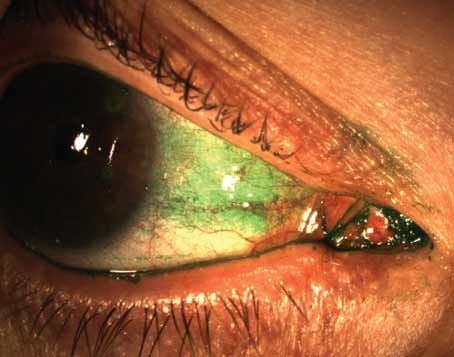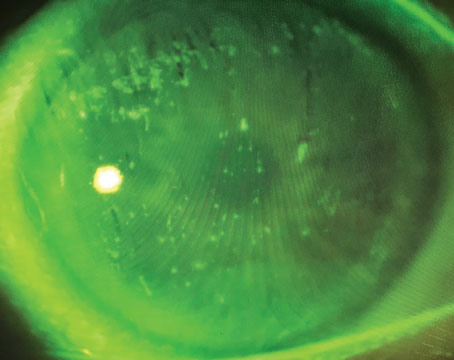We know that the use of screens can have multiple undesirable effects on the eye. The pediatric eye is particularly susceptible to damage during the years of development and excessive screen time can result in both temporary and permanent afflictions. This is important to consider against the backdrop of the coronavirus pandemic, during which screen time has significantly increased. Here, we’ll discuss common pediatric afflictions such as asthenopia, myopia and eye muscle problems, as well as recommendations from the American Academy of Pediatrics that can help your patients’ parents regulate their children’s screen time.
The Scope of the Issue
In the era of computers and smart phones, it is hard to imagine a task that hasn’t been made easier by some sort of technology. Electronic gadgets and screens are being used more often, and children are exposed to devices at younger and younger ages. Our use of devices such as televisions, computers, laptops, e-readers and cell phones has increased exponentially over the past few decades. Reports have suggested that, in 2013, before age 8, 72 percent of children used digital tools compared to 38 percent in 2011. In children under 2, this percentage is even more striking, with electronic use increasing from 10 percent in 2011 to 38 percent in 2013.1 In a recent survey of people ages 16 to 19, the average screen time was between five and seven hours a day.2 In another study, children ages 3 to 11 played with an interactive screen for more than 30 minutes a day, and about half of that time was spent alone.3
Undeniably, the use of screens in our daily lives has multiple advantages. Electronic gadgets are portable, easy-to-use and can provide extensive amounts of information at the tap of a finger. However, despite these devices’ usefulness, the extent to which the average child uses screens has raised red flags in terms of the effect it might have on his or her eyes. Amid the current pandemic, most schools in the United States have been forced to close, and the resulting use of alternative methods of teaching has forced the screen time of kids to increase drastically. Children are having to complete a school curriculum entirely on a screen. In addition, social distancing has decreased recreational activities, resulting in even more screen time. In light of these changes, it’s important to take into account the effect these screens have on children’s eyes and regulate the use of screens in order to prevent permanent damage.
Asthenopia
Asthenopia is a very common effect of excessive screen use, and is prevalent among both children and adults. It’s commonly called “eyestrain,” or “computer vision syndrome.”
In a study involving 576 school-age children between 11 and 17 years old, 18 percent experienced eyestrain at the end of the day after working on digital devices.4 Asthenopia is caused by a multitude of factors, including an imbalance of the extraocular muscles, accommodative insufficiency, uncorrected refractive error and improper lighting.5 Reading distance also contributes significantly to the development of asthenopia. The ideal distance for reading and writing is considered to be between 30 and 40 cm; for a computer screen it should be 50 to 70 cm.6 The reading distance for a smartphone is 20 to 30 cm—significantly closer than reading or computer distance—which causes a majority of patients to develop asthenopic symptoms after only an hour of use.7
In a study performed in China that involved 4,786 students, the prevalence of asthenopia was 53.3 percent and was positively correlated with the level of digital reliance and time spent on handheld devices at bedtime. Prevalence of asthenopia was negatively correlated with aerobic exercise duration.8 The study suggested the following measures to prevent asthenopia: limiting the amount of time spent using digital devices in bed (less than 30 minutes); adopting a posture of lying on one’s back while using digital devices in bed; and engaging in aerobic exercise for more than an hour per day.8 Although asthenopia is a temporary condition, and often subsides after spending time away from the screen, the frequency at which a child uses the screen can affect the severity and rate of asthenopia. If persistent, symptoms of asthenopia can have deleterious effects on academic performance.
Myopia
The rapid rise in children’s consumption of electronic media has occurred alongside another frightening trend: increases in childhood myopia.
The number of children with myopia in the United States has doubled in the past 50 years. Moreover, up to 90 percent of teens and young adults in Asia are myopic. The pathogenesis of myopia is multifactorial and includes genetic and environmental factors. One common hypothesis among scientists is that the light rays emitted by screens hasten eye growth, causing the eyes to become longer and more myopic earlier in life. Investigators collected data from 26,433 preschoolers as part of the Longhua Child Cohort Study performed in the Longhua District of Shenzhen, China, and found that screen exposure in early life might be associated with the onset of preschool myopia, with the strongest association being in the first year of life.9 It’s been clearly documented in randomized trials that spending time outdoors minimizes myopia progression.10
For children, however, the increasing time on the screen decreases the time available for outdoor activities. In the Netherlands, a study was undertaken to evaluate the effect of digital devices on myopia progression. This study evaluated 5,074 children born between 2002 and 2006 and measured the axial length and refractive error at ages 6 and 9. Questionnaires about electronic use were collected at ages 3, 6 and 9 years. This study found that “near work”—defined as a combination of computer use, reading time and reading distance—increased the odds for the development of myopia at age 9. Outdoor exposure decreased these odds.11 All of this collective data suggests that larger amounts of screen time during childhood may lead to myopia.
Strabismus
Eye alignment and the maintenance of stereoacuity is carefully maintained, in part, by the extraocular muscles. Some studies suggest a relationship between esotropia and excessive electronic use. Researchers reviewed the electronic records of 12 patients with acute acquired comitant esotropia and recorded the duration of smartphone use. Reduction in esodeviation was noted in all patients who refrained from smartphone use. Surgical correction was required in three patients for residual deviation after refraining from smartphone use.12 This study raised a strong suspicion that excessive screen time can lead to strabismus and a subsequent loss of stereoacuity. Future studies are needed to better correlate the effects of device use on extraocular muscle function.
Blue-light Effects
Most electronics use backlighting for display screens, which gives off shorter wavelength, ultraviolet blue light rays. Though blue light rays directly from the sun can damage the retina, the blue light from screens is comparatively weaker. Though it can’t directly damage the retina, this blue light can disrupt children’s circadian rhythms and lead to sleep-cycle deregulation. When children watch screens right before bed, the blue light rays can throw off their circadian rhythm, making them feel more awake. This can lead to insomnia and interference with sleep schedules. Therefore, it’s recommended that all device use be discontinued at least one to two hours before bedtime in order to reduce the detrimental effects of blue light on circadian rhythm.
Guidelines for Electronic Use
Despite the potential adverse effects of screen time on a child’s eyes, it’s not practical to cut off screen time for children altogether. Rather, a balance must be achieved in which the child is still able to access screens without it posing a harm to her health.
To this end, the American Academy of Pediatrics has proposed a set of guidelines for managing a child’s screen time.13 The AAP advises that children under 18 months shouldn’t be exposed to screens (other than for video calls). They suggest that children between 18 months and 5 years watch no more than one hour per day of digital content. Programming should be educational, prosocial and include parental interaction for children to reap the most benefit during this time of critical brain development. Children ages 6 and above may have more liberal screen time use, but within reason. The AAP also recommends that families should try to implement “positive” screen time, which involves the family watching together so that the time is more interactive. In addition, for older children, it’s recommended that screens be located centrally in the house so that content can be monitored. Finally, the AAP recommends that parents should impose specific times at which their children unplug and engage in non-screen activities.
In conclusion, excessive use of screens in childhood can have many negative effects. Unregulated amounts of screen time may lead to ailments like asthenopia, myopia and disrupted oculomotor function. Greater information regarding the effects of screen time on eye and vision development will be immensely valuable, given the increasing presence of electronics in our daily lives. This is especially important during the coronavirus pandemic when screen time for children has escalated dramatically. (Data from Axios suggests that tablet use has tripled and cell phone usage has doubled during the pandemic.14) By following the guidelines from the AAP and regulating screen time for children, parents can ensure safe and reasonable screen usage for their children. REVIEW
Dr. Ramasubramanian is a pediatric ophthalmologist, and is medical director of the Phoenix Children’s retinoblastoma program. Ms. Venkatasubramanian is Dr. Ramasubramanian’s research assistant.
Neither author has a financial interest associated with the article.
Corresponding Author: Aparna Ramasubramanian, MD. Email: aramasubramanian@
phoenixchildrens.com. Phone: 602-933-3937. Fax: 602-933-2409
1. Dennison BA, Erb TA, Jenkins PL. Television viewing and television in bedroom associated with overweight risk among low-income preschool children. Pediatrics 2002;109:1028-1035.
2. Hysing M, Pallesen S, Stormark KM, et al. Sleep and use of electronic devices in adolescence: Results from a large population based study. BMJ Open. 2015:e006748.
3. Assathiany R, Guery E, Caron FM. Children and screens: A survey by French pediatricians. Arch Pediatr 2018;25:2:84-88.
4. Ichhpujani P, Singh RB, Foulsham W, et al. Visual implications of digital device usage in school children: A cross-sectional study. BMC Ophthalmol 2019;19:1:76.
5. Bali J, Navin N, Thakur BR. Computer vision syndrome: A study of the knowledge, attitudes and practices in Indian ophthalmologists. Indian J Ophthalmol 2007;55:4:289.
6. Rempel D, Willms K, Anshel J, et al. The effects of visual display distance on eye accommodation, head posture, and vision and neck symptoms. Hum Factors 2007;49:5:830-838.
7. Long J, Cheung R, Duong S, Paynter R, Asper L. Viewing distance and eyestrain symptoms with prolonged viewing of smartphones. Clin Exp Optom 2017;100:2:133-137.
8. Xu Y, Deng G, Wang W, et al. Correlation between handheld digital device use and asthenopia in Chinese college students: A Shanghai study. Acta Ophthalmol 2019;97:3:e442-e447.
9. Yang GY, Huang LH, Schmid KL, et al. Associations between screen exposure in early life and myopia amongst Chinese preschoolers. Int J Environ Res Public Health 2020;17:3.
10. Wu PC, Chen CT, Chang LC, et al. Increased time outdoors is followed by reversal of the long-term trend to reduced visual acuity in Taiwan primary school students. Ophthalmology 2020;S0161-6420:20:30139-1.
11. Enthoven CA, Tideman JWL, Polling JR, et al. The impact of computer use on myopia development in childhood: The Generation R study. Prev Med 2020 Mar. Epub Jan. 15, 2020.
12. Lee HS, Park SW, Heo H. Acute acquired comitant esotropia related to excessive Smartphone use. BMC Ophthalmol 2016;16:37.
13. AAP Council on Communications and Media. Media and young minds. Pediatrics 2016;138:5:e20162591.
14. Fischer S. Kids’ daily screen time surges during coronavirus. Online article. https://www.axios.com/kids-screen-time-coronavirus-562073f6-0638-47f2-8ea3-4f8781d6b31b.html. Accessed 19 June 2020.






